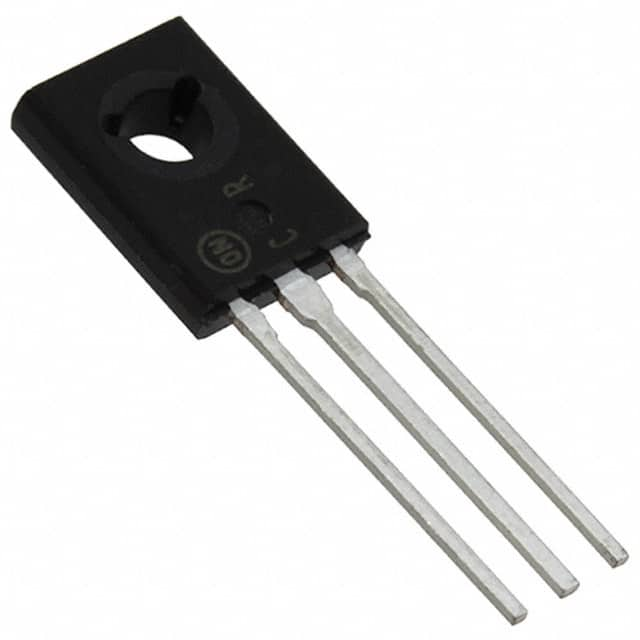Viz Specifikace pro podrobnosti o produktu.

BD435G Product Overview
Product Category: Transistor
Use: The BD435G transistor is commonly used as a switching device in electronic circuits. It can be utilized in various applications such as amplification, signal processing, and power control.
Characteristics: The BD435G is a PNP bipolar junction transistor (BJT) with a maximum collector current of 4A and a maximum collector-emitter voltage of 45V. It is designed for general-purpose amplifier and low-speed switching applications.
Package: The BD435G is typically available in a TO-126 package, which provides easy mounting and heat dissipation.
Essence: This transistor is essential for controlling the flow of current in electronic circuits, enabling precise amplification and switching operations.
Packaging/Quantity: The BD435G is commonly sold in reels or tubes containing multiple units, making it suitable for mass production and industrial applications.
Specifications
The detailed specifications of the BD435G transistor include: - Maximum Collector Current: 4A - Maximum Collector-Emitter Voltage: 45V - DC Current Gain (hFE): 25 - 250 - Power Dissipation: 40W - Transition Frequency: 2MHz
Detailed Pin Configuration
The BD435G transistor has three pins: the emitter, base, and collector. The pin configuration is as follows: - Emitter (E): Pin 1 - Base (B): Pin 2 - Collector (C): Pin 3
Functional Features
The BD435G transistor offers the following functional features: - High current and voltage capability - Low saturation voltage - Fast switching speed - Reliable performance in various operating conditions
Advantages and Disadvantages
Advantages: - Suitable for general-purpose applications - Robust construction for reliable operation - Cost-effective solution for electronic circuit design
Disadvantages: - Limited frequency response compared to specialized transistors - Higher power dissipation in certain operating conditions
Working Principles
The BD435G operates based on the principles of bipolar junction transistors, where the flow of current between the collector and emitter is controlled by the base current. By modulating the base current, the transistor can amplify signals or act as a switch in electronic circuits.
Detailed Application Field Plans
The BD435G transistor finds extensive use in the following application fields: - Audio amplifiers - Power supply circuits - Motor control systems - LED drivers - Voltage regulators
Detailed and Complete Alternative Models
Some alternative models to the BD435G transistor include: - BD437G - BD439G - 2N3906 - TIP32C - MJE3055T
This diverse range of alternative models provides flexibility in selecting the most suitable transistor for specific circuit requirements.
Word Count: 410
Seznam 10 běžných otázek a odpovědí souvisejících s aplikací BD435G v technických řešeních
What is BD435G?
- BD435G is a PNP silicon power transistor designed for use in general-purpose amplifier and switching applications.
What are the key specifications of BD435G?
- The key specifications include a collector-emitter voltage (VCEO) of 45V, collector current (IC) of 4A, and a total power dissipation (PTOT) of 40W.
In what technical solutions can BD435G be used?
- BD435G can be used in audio amplifiers, power supply circuits, motor control circuits, and general switching applications.
What are the typical operating conditions for BD435G?
- The typical operating conditions include a collector current (IC) of 1A, a collector-emitter voltage (VCE) of 5V, and a base-emitter voltage (VBE) of 1V.
What are the thermal characteristics of BD435G?
- The thermal resistance from junction to case (RthJC) is 5°C/W, and the thermal resistance from junction to ambient (RthJA) is 83°C/W.
Can BD435G be used in high-power applications?
- BD435G is suitable for medium-power applications, but for high-power applications, it is recommended to consider devices with higher power ratings.
What are the typical gain and frequency characteristics of BD435G?
- The DC current gain (hFE) typically ranges from 40 to 160, and the transition frequency (fT) is around 3MHz.
Are there any specific considerations for driving BD435G in switching applications?
- It is important to ensure proper base drive and adequate heat sinking when using BD435G in switching applications to maintain its performance and reliability.
What are the potential alternatives to BD435G for similar applications?
- Alternatives to BD435G include transistors such as BD437G, BD439G, and BD441G, which offer similar characteristics and performance.
Where can I find detailed application notes and circuit examples for using BD435G?
- Detailed application notes and circuit examples for using BD435G can be found in the manufacturer's datasheet and application notes, as well as in technical reference manuals and online resources related to transistor applications.

